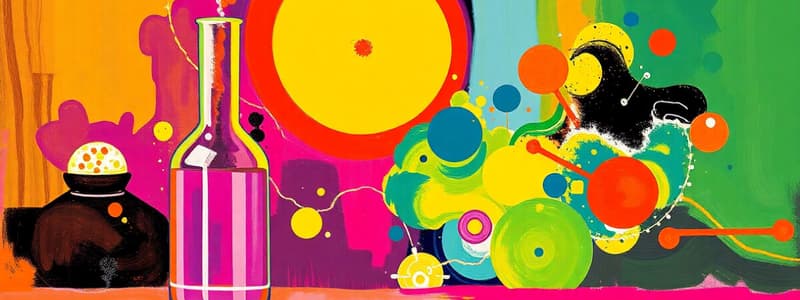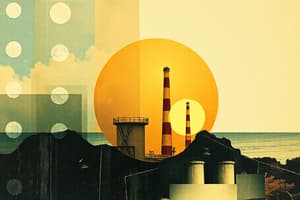Podcast
Questions and Answers
Why is it important to decrease sulfur in fuel?
Why is it important to decrease sulfur in fuel?
- It increases the overall efficiency of the fuel.
- It produces a significant amount of energy.
- It causes more complete combustion.
- It produces SO2, which is a toxic gas. (correct)
What is the molar mass of CO2 produced from the complete combustion of carbon?
What is the molar mass of CO2 produced from the complete combustion of carbon?
- 12 g/mol
- 60 g/mol
- 32 g/mol
- 44 g/mol (correct)
In the balanced equation C2H6+(7/2)O2=>2CO2+3H2O, what is the mole ratio of C2H6 to CO2?
In the balanced equation C2H6+(7/2)O2=>2CO2+3H2O, what is the mole ratio of C2H6 to CO2?
- 1:2 (correct)
- 2:2
- 1:3
- 2:3
How much oxygen is needed for the complete combustion of 1 kg of carbon based on the given calculations?
How much oxygen is needed for the complete combustion of 1 kg of carbon based on the given calculations?
Which equation best represents the combustion of ethanol (C3H7OH)?
Which equation best represents the combustion of ethanol (C3H7OH)?
What relationship does Boyle's law describe?
What relationship does Boyle's law describe?
In Charles's law, which two variables are directly proportional?
In Charles's law, which two variables are directly proportional?
What does Avogadro's law state about the volume of a gas?
What does Avogadro's law state about the volume of a gas?
What does the ideal gas law equation represent?
What does the ideal gas law equation represent?
When considering Dalton's law for partial pressure, how is the total pressure calculated?
When considering Dalton's law for partial pressure, how is the total pressure calculated?
Under what conditions do ideal gases accurately represent real gases?
Under what conditions do ideal gases accurately represent real gases?
In the combined gas law, if the temperature increases while pressure remains constant, how is volume affected?
In the combined gas law, if the temperature increases while pressure remains constant, how is volume affected?
What is the function of the constant R in the ideal gas law?
What is the function of the constant R in the ideal gas law?
What is the primary purpose of the rotary kiln's inclined design?
What is the primary purpose of the rotary kiln's inclined design?
What reaction occurs in the calcination zone of the rotary kiln?
What reaction occurs in the calcination zone of the rotary kiln?
Which of the following describes the relevance of iron oxide (Fe2O3) in cement production?
Which of the following describes the relevance of iron oxide (Fe2O3) in cement production?
Why is complete combustion preferred over incomplete combustion?
Why is complete combustion preferred over incomplete combustion?
What is the primary material used in the grinding process before cement production?
What is the primary material used in the grinding process before cement production?
What occurs during the pre-heating zone of the rotary kiln?
What occurs during the pre-heating zone of the rotary kiln?
What temperature range defines the burning zone in the rotary kiln?
What temperature range defines the burning zone in the rotary kiln?
What is the function of gypsum added during the final grinding of cement?
What is the function of gypsum added during the final grinding of cement?
What is the primary cause of deviation from ideal gas behavior?
What is the primary cause of deviation from ideal gas behavior?
Which type of corrosion occurs due to a direct chemical reaction with the environment?
Which type of corrosion occurs due to a direct chemical reaction with the environment?
In an electrochemical cell, what is the role of the anode?
In an electrochemical cell, what is the role of the anode?
Which of the following factors is NOT mentioned as affecting corrosion?
Which of the following factors is NOT mentioned as affecting corrosion?
What is the formula to calculate the effusion velocity of a gas?
What is the formula to calculate the effusion velocity of a gas?
Which type of corrosion is primarily caused by mechanical wear and chemical reactions?
Which type of corrosion is primarily caused by mechanical wear and chemical reactions?
What protective measure can be taken to reduce the likelihood of galvanic corrosion?
What protective measure can be taken to reduce the likelihood of galvanic corrosion?
Which of the following describes the process of gas diffusion?
Which of the following describes the process of gas diffusion?
In rusting, what happens at the cathode with oxygen-rich non-acidic conditions?
In rusting, what happens at the cathode with oxygen-rich non-acidic conditions?
Which type of coating involves a more active metal covering a less active one?
Which type of coating involves a more active metal covering a less active one?
Flashcards
Boyle's Law
Boyle's Law
States the relationship between the volume (V) and pressure (P) of a gas when temperature (T) and the number of moles (n) are constant. The volume and pressure are inversely proportional, meaning that as pressure increases, volume decreases, and vice versa.
Charles's Law
Charles's Law
Describes the relationship between the volume (V) and temperature (T) of a gas when pressure (P) and the number of moles (n) are constant. The volume and temperature are directly proportional, meaning that as temperature increases, the volume increases, and vice versa.
Avogadro's Law
Avogadro's Law
States the relationship between the volume (V) and the number of moles (n) of a gas when pressure (P) and temperature (T) are constant. The volume and the number of moles are directly proportional, meaning that as the number of moles increases, the volume increases, and vice versa.
Ideal Gas Law
Ideal Gas Law
Signup and view all the flashcards
Van der Waals Equation
Van der Waals Equation
Signup and view all the flashcards
Dalton's Law of Partial Pressures
Dalton's Law of Partial Pressures
Signup and view all the flashcards
Mole Fraction
Mole Fraction
Signup and view all the flashcards
Ideal vs. Real Gas Conditions
Ideal vs. Real Gas Conditions
Signup and view all the flashcards
Volume of Molecules in Real Gas
Volume of Molecules in Real Gas
Signup and view all the flashcards
When to Consider Volume of Molecules
When to Consider Volume of Molecules
Signup and view all the flashcards
Attraction Force Between Molecules
Attraction Force Between Molecules
Signup and view all the flashcards
Ideal Gas Conditions
Ideal Gas Conditions
Signup and view all the flashcards
Conditions for Deviation from Ideal Gas
Conditions for Deviation from Ideal Gas
Signup and view all the flashcards
Gas Diffusion
Gas Diffusion
Signup and view all the flashcards
Gas Effusion
Gas Effusion
Signup and view all the flashcards
Corrosion
Corrosion
Signup and view all the flashcards
Chemical Corrosion
Chemical Corrosion
Signup and view all the flashcards
Electrochemical Corrosion
Electrochemical Corrosion
Signup and view all the flashcards
Clay
Clay
Signup and view all the flashcards
Lime stone
Lime stone
Signup and view all the flashcards
Rotary kiln
Rotary kiln
Signup and view all the flashcards
Drying Zone
Drying Zone
Signup and view all the flashcards
Calcination Zone
Calcination Zone
Signup and view all the flashcards
Burning Zone
Burning Zone
Signup and view all the flashcards
Hydrocarbons
Hydrocarbons
Signup and view all the flashcards
Hydrogen
Hydrogen
Signup and view all the flashcards
Theoretical Air
Theoretical Air
Signup and view all the flashcards
Excess Air
Excess Air
Signup and view all the flashcards
Actual Air
Actual Air
Signup and view all the flashcards
Energy Released from Fuel Combustion
Energy Released from Fuel Combustion
Signup and view all the flashcards
Why is it important to decrease sulfur in fuel?
Why is it important to decrease sulfur in fuel?
Signup and view all the flashcards
Study Notes
Gases
- Factors affecting gas behavior:
- Temperature (T) (K) = (°C + 273)
- Pressure (P) (atm) = 760 torr (mmHg) or 1.01325 x 10⁵ Pa (N/m²)
- Volume (V) (liters)
- Number of moles (n) (moles) = (mass/molar mass)
- Gas laws:
- Boyle's law: Studies the relationship between volume (V) and pressure (P) when temperature (T) and the number of moles (n) are constant. Volume and pressure are inversely proportional (V α 1/P).
P₁V₁ = P₂V₂ - Charles's law: Studies the relationship between volume (V) and temperature (T) when pressure (P) and the number of moles (n) are constant. Volume and temperature are directly proportional (V α T). V₁/T₁ = V₂/T₂
- Avogadro's law: Studies the relationship between volume (V) and the number of moles (n) when pressure (P) and temperature (T) are constant. Volume and the number of moles are directly proportional (V α n). n₁/V₁ = n₂/V₂
- Ideal gas law: PV = nRT (where R is the ideal gas constant = 0.08206 liter⋅atm/mol⋅K)
- Combined gas law: P₁V₁/T₁ = P₂V₂/T₂
- Boyle's law: Studies the relationship between volume (V) and pressure (P) when temperature (T) and the number of moles (n) are constant. Volume and pressure are inversely proportional (V α 1/P).
Corrosion
- Corrosion: Destruction of material properties due to reaction with the environment.
- Types of Corrosion:
- Chemical (dry, direct, gas)
- Electrochemical (indirect, wet)
- Electrochemical Cell:
- Electrolytic: Changes electrical energy to chemical energy (non-spontaneous)
- Galvanic: Changes chemical energy to electrical energy (spontaneous)
- Factors affecting corrosion:
- Air (moisture, humidity, temperature, pollution)
- Water (temperature, pollution, salts)
- Soil (pollution, salts, water, gases)
- Gas (acidity [SOx, NOx, H₂S])
- Activity series: A list of metals ordered by their tendency to lose electrons in a redox reaction. Those higher on the list are more easily oxidized (more active).
- Types of Corrosion:
- Uniform corrosion
- Atmospheric corrosion
- Factors affecting (type of environment, temperature, time, type of material, surface condition, oxide layer)
- Non-uniform corrosion
- Erosion corrosion:
- Factors affecting (turbulence, suspended solids, hardness)
- Stress corrosion cracking
- Factors affecting (time, stress, type of surrounding, type of metal)
- Erosion corrosion:
- Galvanic corrosion: Occurs when two dissimilar metals are in contact in a corrosive environment.
- Factors affecting (potential difference, distance from contact point, area cathode/anode)
- Uniform corrosion
- Rusting of Iron:
- Anode: Fe → Fe²⁺ + 2e⁻
- Cathode: O₂ + 2H₂O + 4e⁻ → 4OH⁻
- Equation: 2Fe + O₂ + 2H₂O → 2Fe(OH)₂ (Further oxidation forms rust, Fe₂O₃•xH₂O)
Corrosion Protection
- Methods:
- Material Selection
- Design (avoid galvanic corrosion, stress corrosion cracking, atmospheric corrosion)
- Coating (anodic: more active metal covers a less active one; cathodic: less active metal covers a more active one)
Concrete and Cement
- Components: Sand, rock, water, and cement
- Cement:
- Clay (Al₂O₃ ⋅ 2SiO₂ ⋅ 2H₂O)
- Limestone (CaCO₃)
- Cement Manufacturing Process:
- Crushing limestone, grinding limestone (in a ball mill), storing and mixing limestone and clay in silos, preheating zone(400–700°C), calcination zone (700–1000°C), burning zone (1000–1500°C), adding Gypsum, cooling
Rotary Kiln
- Properties: Inclined at 3-6 degrees, rotates to prevent material coagulation, has a fan to remove unwanted gases
- Zones of Rotary Kiln:
- Drying zone (100-400°C): evaporates physical water
- Pre-heating zone (400–700°C): evaporates chemical water, decomposition of clay (Al₂O₃ ⋅ 2SiO₂)
- Calcination zone (700–1000°C): decomposition of limestone (CaCO₃) to lime (CaO) and carbon dioxide (CO₂)
- Burning zone (1000–1500°C): reactions to form cement clinker
Fuel and Combustion
- Fuels: Materials that combust or react with oxygen (O₂) to produce energy.
- Main Combustion Reactions:
- Complete combustion: fuel + oxygen → carbon dioxide (CO₂) + energy
- Incomplete combustion: fuel + oxygen → carbon monoxide (CO) + energy (less energy and toxic)
- Factors affecting fuel choice: energy produced, toxicity of products.
- Importance of sulfur reduction in fuels: Sulfur forms toxic gases in combustion.
- Calculating theoretical and actual air supply: Equations involve percentages of elements in the fuel and reactions.
Studying That Suits You
Use AI to generate personalized quizzes and flashcards to suit your learning preferences.



